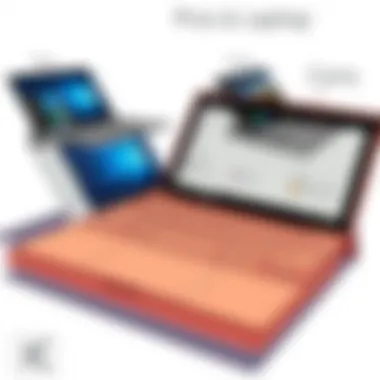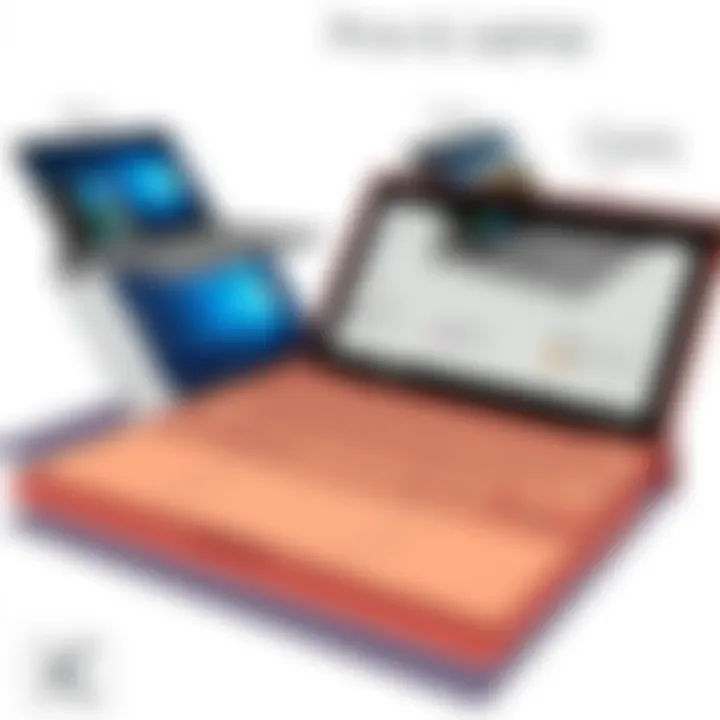Exploring Surface Laptop Sizes and Their Impact


Intro
In today's fast-paced digital age, laptops have become a vital companion for many. Microsoft has carved out a niche with its Surface lineup, known for blending sleek design with powerful performance. But as you consider which Surface laptop may tickle your fancy, the first aspect to ponder is size.
Understanding the dimensions of these devices isn't just a trivial detail; it can profoundly influence how you interact with your technology. The right size laptop caters to your specific needs, whether you prioritize portability, screen real estate, or ergonomic comfort.
This exploration sets the stage to unpack the key features of Surface laptops, focusing on what makes each size unique and why these distinctions matter. Along with contemplating design and performance, consider how these dimensions affect usability in real-world scenarios. It’s not merely about picking a model; it’s about ensuring that choice aligns with how you work and play in the digital sphere.
So, let’s dive into the essential features – from the build quality to display capabilities – and discern the nuances that will aid in choosing your next laptop.
Preface to Surface Laptop Size
In the ever-evolving world of technology, the size of a laptop plays a pivotal role in its usability and appeal. This rings particularly true for the Surface Laptop series, which encompasses a range of models designed to cater to diverse user needs.
Understanding the size variations in Surface Laptops isn’t just a matter of aesthetics; it transcends to user experience, portability, and functionality. The first thing to consider is the physical dimensions—it can greatly influence how one interacts with their device. A larger screen often provides a more immersive experience for tasks such as graphic design or video editing, while a smaller laptop could be easier to carry around for students attending classes.
With technology moving swiftly, consumers have become increasingly savvy when it comes to choosing laptops. The emphasis on discerning size options makes this section critical, as it guides the reader through a maze of choices. Here, we will delve into the models available, emphasizing how their differing sizes serve distinct purposes.
"The right laptop size is more than just a preference; it's a fundamental choice that affects daily productivity and overall comfort."
As we evaluate the Surface Laptop models, several factors come into play. This includes performance aspects, aesthetic considerations, and even market trends. Laying down a solid foundation here allows readers to make informed decisions.
Therefore, as we navigate through the overview, we’ll pinpoint what makes each model unique while reinforcing the importance of size in making the right selection.
Size Variations in Surface Laptop Series
When diving into the world of Surface laptops, understanding size variations is crucial. Each model in this dynamic lineup comes with its own set of dimensions that cater to different user needs. Whether you prioritize portability, screen space, or overall usability, the differences in size can significantly influence your experience. Let’s take a closer look at the various models, as they not only differ in specifications but also in how they are designed to fit diverse lifestyles and tasks.
Surface Laptop One
The Surface Laptop One marked the beginning of a new era for Microsoft’s offerings. Launched with simplicity and elegance, this device comes in a compact size that makes it a choice for those who frequently travel or engage in daily commutes.
- Display Size: 13.5 inches, which strikes a good balance between being large enough for multitasking and small enough to fit comfortably in a backpack.
- Weight: Weighing approximately 2.76 pounds, it’s light enough to carry around all day without breaking a sweat.
This model is ideal for students and casual users who need a reliable device without the frills. The size allows it to squeeze into tight spaces yet offers enough screen real estate for note-taking and browsing. One downside, however, is that for graphic design or video editing, some might find the screen a tad limiting.
Surface Laptop Go
Next up is the Surface Laptop Go, which quite literally embodies the phrase "good things come in small packages". This model appeals to users who want performance without the bulk.
- Display Size: 12.4 inches, making it highly portable and perfect for on-the-go usage.
- Weight: Only 2.45 pounds, which is featherlight compared to many competing models.
This device is particularly attractive to the younger audience, especially those in educational environments. Its size encourages easy handling for group activities or presentations. However, some find its smaller size could mean a compromise on comfort when it comes to typing for extended periods.
Surface Laptop Studio
On the other side of the spectrum, we have the Surface Laptop Studio—designed for the creative professionals who demand more from their device. Its dimensions are vastly different, catering to a more immersive experience.
- Display Size: 14.4 inches, which offers ample screen area for those dedicated to design and multimedia tasks.
- Weight: A bit heftier at around 4 pounds, but this is expected considering its powerful hardware.
This laptop’s size supports its transformative design, allowing users to switch between laptop and tablet modes effortlessly. Even so, professionals should consider its weight if frequent travel is a regular part of their workflow.
Surface Laptop Four
Lastly, the Surface Laptop Four continues the legacy of its predecessors while making significant advancements, making it particularly appealing to tech enthusiasts.


- Display Size: Available in both 13.5 and 15 inches, this provides options depending on personal preference.
- Weight: The 13.5-inch model remains portable at around 2.79 pounds, whereas the 15-inch version weighs about 3.4 pounds.
This model is well-rounded, catering to a range of professional environments. Whether one is engaging in business presentations or creative projects, the size options allow for customization while balancing performance and portability. Nonetheless, potential buyers may want to think about whether they favor a lighter laptop or can accommodate additional weight for a larger display.
In summary, each Surface Laptop model presents unique attributes and dimensions that cater to various user requirements. Understanding these size variations can aid in selecting the right device that seamlessly fits within one’s lifestyle.
Comparative Analysis of Dimensions
The nuances in dimensions between the various Surface laptop models merit a thorough analysis. Understanding this aspect is crucial for potential buyers and enthusiasts since dimensions directly affect factors such as usability, portability, and even performance. In this segment, we'll break down the key elements associated with width, height, thickness, and weight, helping readers make informed choices based on their unique needs.
Width and Height Considerations
When it comes to laptops, the width and height might seem trivial initially, but these measurements can significantly shape the user experience. The right width ensures ample screen space and enhances productivity, especially for multitaskers.
For instance, the Surface Laptop 4, with its 13.5-inch display, strikes a balance between portability and usability. It’s not overly clunky, but provides a decent canvas for tasks such as graphic design or spreadsheets. On the other hand, the Surface Laptop Studio, boasting a 14.4-inch screen, offers a more expansive viewing area ideal for creative professionals involved in video editing or design work. These dimensions enable users to visualize larger projects without squinting or adjusting their screens constantly.
Let's not forget the height. A taller laptop can lead to discomfort when looking down for prolonged periods. Hence, laptops like the Surface Laptop Go, which is designed to be lightweight and compact, cater to those who need to use their devices on the go, whether in a coffee shop or a crowded subway.
In summary, considering width and height is not just about aesthetic preferences; it affects productivity, comfort, and overall functionality depending on the user's environment and tasks.
Thickness and Weight Balance
Next up is thickness and weight, two metrics that go hand in hand, especially when discussing portability. When a laptop is too heavy or thick, it may discourage users from taking it on the road, leading to those oh-so-familiar regrets of having left gear home.
The Surface Laptop Go, for example, impresses with its remarkably thin design. Weighing just about 2.45 pounds, it’s an easy companion for students hustling from class to class. In contrast, if you cast your gaze towards the Surface Laptop Studio, while it’s thicker and heavier, its design allows for high performance. However, users may need to make the sacrifice of carrying a bit of extra weight if they are seeking a powerhouse.
Trade-offs are inevitable. A thinner laptop often suggests less battery and performance power, and the Surface Laptop 4 showcases this balance beautifully. Manufacturers spend countless hours perfecting this equilibrium to ensure that users get the best of both worlds – a slim device with enough guts to perform.
Ultimately, whether opting for a lighter model like the Surface Laptop Go or a performance-centric choice such as the Surface Laptop Studio, it’s about discerning one's priorities. Choosing a laptop that balances thickness and weight aligns with personal usage, creating a tailor-fitted experience that isn’t sacrificed on the altar of convenience.
"In the end, the best laptop for you hinges on how well it aligns with your specific needs and lifestyle."
Understanding these dimensions allows users to weigh their options with competence, ensuring decisions align with their daily usage and preferences.
Impact of Size on User Experience
When selecting a laptop, size isn't just a number—it's a defining factor that can make or break the user experience. The dimensions of a device dictate everything from how easily it fits into a backpack to how comfortable it is for extended use. Users today are discerning, and understanding how size affects experience can guide them in making decisions that align with their needs and lifestyle.
Portability vs. Screen Real Estate
In the world of laptops, portability often dances a fine waltz with screen real estate. Many users find themselves in a pickle, trying to balance having a sizable screen for their work or entertainment against the need to carry their device around.
For instance, a Surface Laptop with a 15-inch display might offer a larger viewing area, making it ideal for graphic-intensive tasks or multitasking. However, this size can be a burden on your back, especially if you’re a student or a professional on the go. These machines can feel like a weighty dilemma when running for a bus or trying to merge into a crowded café seat.
Conversely, smaller models, like the Surface Laptop Go, can easily slide into a messenger bag. However, they come with the trade-off of reduced screen space. Tasks like editing video or working on complex spreadsheets can feel constrained on a smaller display, making your workday more of a squint-and-sweat scenario than a smooth sailing.
Ultimately, the choice boils down to personal need: Do you primarily work in one location or are you on the move? Each user must weigh how much screen space they can compromise for convenience, considering that the ideal laptop serves as both a companion and a tool.
Keyboard and Touchpad Functionality
In addition to screen size, the dimensions of a laptop also play a significant role in keyboard and touchpad functionality. A cramped, small keyboard can frustrate typists and lead to errors—no one enjoys typing a report and having their fingers dance on the wrong keys. The touchpad, often overlooked, can also become unwieldy if it’s too small or poorly positioned.
For example, larger Surface models typically provide more spacious keyboards and touchpads, allowing for a more comfortable typing experience. This is crucial for tasks requiring precision, such as programming code or crafting business proposals. Users appreciate when they can stretch their fingers without feeling like they're wrestling with the device.
Smaller models, by contrast, might require users to adjust their typing style, leading to fatigue over long periods of use. The challenge is in finding a device that aligns with both typing comfort and portability.
Choosing a laptop is rarely straightforward, and size plays an essential part in the overall user experience. By understanding how screen dimensions and keyboard layouts interact with your daily tasks, you can arrive at a more informed decision, picking a Surface Laptop that feels just right.


Usability in Different Scenarios
Understanding how various Surface laptop sizes cater to specific user needs is crucial for making an informed decision. The usability of these devices changes significantly depending on the environment and tasks at hand. The differences in weight, screen size, and keyboard layout can play a pivotal role in shaping an individual’s experience. Let’s break this down further.
Ideal for Students
Surface laptops really shine in academic settings. With educational demands, students often find themselves balancing heavy workloads, which makes portability a top concern. For instance, the Surface Laptop Go, with its lightweight design and compact dimensions, fits neatly into a backpack without weighing them down.
Another notable benefit is the screen size. Students need a display that is large enough for multitasking but small enough to take with them from class to class. The 12.4-inch screen of the Surface Laptop Go offers a solid compromise. Most importantly, students appreciate the battery life that allows them to go through a long day without having to hunt down a power outlet.
When they’re juggling between notes and online resources, the device’s responsive keyboard and touchpad become essential tools, making note-taking smoother and more efficient. The portability gives them an edge during group discussions or study sessions at a coffee shop.
Professional Environments
In the corporate world, size and design become key factors in determining which Surface laptop fits the bill. For professionals who need to make presentations or conduct meetings, the Surface Laptop Studio’s premium build and striking display bring their work to life. The larger 14.4-inch screen enables clear visibility, and its robust performance is a boon for resource-intensive applications.
However, it's not just about the numbers. Professionals often value the aesthetics that a sleek design brings to conference rooms. The Surface branding is synonymous with quality, and having a device that looks as good as it performs can significantly enhance a person's professional image.
Another aspect worth considering is durability. In professional settings where the laptop might be moved between office spaces, a build that can withstand the rigors of office life is a must. Here, the Surface Laptop 4 stands out with its premium materials and a solid warranty, ensuring that professionals are less likely to encounter issues while on the go.
Creative Professionals
For those entrenched in creative endeavors, such as graphic design or video editing, screen real estate and processing power matter most. The Surface Laptop Studio is particularly appealing here, offering a vibrant display with excellent color accuracy and contrast for graphic work. Artists and designers can benefit from the responsive touchscreen and Surface Pen compatibility, allowing for precise control over their projects.
Lightweight laptops like the Surface Laptop Go can also benefit creative professionals, especially when they're on location for shoots or brainstorming outside the traditional office setting. The flexibility from device to device means they can choose based on whether they need high performance for intensive tasks or portability for on-the-go creativity.
In essence, whether it’s drawing, video editing, or writing, having the right size laptop can make a notable difference in workflow efficiency and satisfaction. Hence, the adaptability of Surface laptops appeals to various scenarios, ensuring a good fit for every user’s unique demands.
"Choosing the right Surface laptop is more than picking a size; it’s about enhancing how you work and creating the best experience tailored to your needs."
By analyzing these different environments, potential buyers can better grasp how Surface laptop sizes not only meet, but also enhance their requirements.
Performance Considerations Related to Size
When it comes to laptops, size isn’t just about looks. Performance considerations are intrinsically tied to dimensions, affecting how effectively a device operates under various conditions. This section explores two critical elements: how the size influences processing power and heat distribution, and the implications for battery life.
Processing Power and Heat Distribution
The relationship between laptop size and processing power is often overlooked. Smaller laptops like the Surface Laptop Go might utilize more compact components, which can limit performance compared to their larger counterparts like the Surface Laptop Studio.
- Compact Components: Smaller devices tend to use mobile processors designed to fit in tight spaces. While these processors can handle everyday tasks, they often lack the raw power needed for heavy lifting, such as video editing or 3D rendering.
- Heat Management: A significant consideration with powerful components is heat. In smaller models, heat buildup can become a serious issue if the cooling system isn’t proportionate to the powerful chips they host. As laptops get thinner, manufacturers need to innovate cooling solutions that effectively discharge heat without compromising portability. High-performance laptops often have larger chassis to accommodate more efficient heat sinks and fan systems. In turn, this ensures that the processor operates at optimal temperatures—thereby increasing longevity and performance under load.
Designing a laptop to balance power and heat is a delicate act. An effectively cooled laptop can handle demanding tasks longer without throttling, which is essential for users who rely on their devices for intensive activities.
Battery Life Implications
Battery life is another crucial factor connected to size. Generally speaking, a larger laptop can accommodate a bigger battery, which can stretch out operating time. However, size doesn’t tell the full story; the efficiency of components also plays a part.
- Battery Size: Larger devices often house more substantial batteries. For instance, the Surface Laptop 4 features a larger battery compared to the Go, which allows it to achieve higher endurance during intensive use. Users who may spend a good chunk of their day unplugged will appreciate this feature.
- Power-Efficient Design: While larger batteries can hold more charge, a laptop's performance also hinges on its energy consumption. Efficient processors can prolong battery life even in smaller models, making them suitable for users who prefer ultra-portability without frequent charging. Furthermore, some laptops are equipped with adaptive technology, adjusting performance based on current tasks to optimize battery longevity.
Important Note: Consider your primary use case—is it for creative work, casual browsing, or both? The right Surface laptop can make all the difference.
For more insights into the specific models, check out these resources:


Design Aesthetics and Size
When discussing laptops, particularly the Surface series, the design aesthetics and size cannot be merely brushed aside. These elements are not just about looks; they play a crucial role in how users connect with their devices. The first impression often stems from the visual appeal, while the size affects practicality and user experience. A laptop must not only perform well but should also resonate with the personal style of its owner.
The interplay of design and size brings out several important components that deserve attention.
Materials and Build Quality
Surface laptops utilize premium materials that reflect elegance and durability. For example, the magnesium alloy chassis provides a sturdy yet lightweight build, giving the device a premium feel. Users value that combination of quality and comfort, as they often carry their devices around, be it in a home office or on a train commute. A solid build can withstand the rigors of day-to-day usage without compromising on the sleek aesthetics that Surface laptops are known for.
Furthermore, the choice of materials contributes to heat management and tactile feedback. The keyboard, crafted from the same high-quality materials, enhances the typing experience. Textures matter; for instance, a smooth finish may feel better in hand than a matte one, impacting overall satisfaction and usability. Different models may present variations — while some have a brushed finish, others opt for a polished look, each catering to different taste preferences.
Color and Finish Options
The color palette offered across the Surface line is another element that speaks volumes. Users can express their individuality through choices that range from classic matte black to vibrant aqua. Each finish presents a unique character, setting the tone for how the device fits into the user’s lifestyle.
"Choosing a Surface laptop isn't just about functionality; it's about reflecting one's personality in everyday tech."
In the realm of color, options matter greatly. Many tech enthusiasts lean toward more subdued tones for professional settings, while playful colors might speak to creative individuals or students. Having diverse finish options allows users to select a device that complements their style rather than clashes with it.
Moreover, the market's trend toward aesthetic minimalism suggests that consumers often prefer sleek, understated designs that still offer a touch of flair. The way a laptop looks can even influence its perceived speed and efficiency.
To sum up, the integration of materials, build quality, color, and finish shape the identity of Surface laptops. They signify a blend of functionality and beauty, enhancing user experience in both personal and professional environments.
Future Trends in Laptop Size
Future trends in laptop design are not merely about keeping up with the times; they represent a fundamental shift in how we interact with technology. As consumers become increasingly dependent on mobility, manufacturers are rethinking what size laptops ought to be. This section will delve into those trends—addressing innovations that shape size and form factor while considering the preferences of the evolving user base.
Streamlined Designs and Innovation
In today's world, less is often more. Laptop designers are focusing on creating slimmer, sleeker models that maintain performance without compromising on usability. For instance, as technology improves, it allows for more efficient cooling mechanisms. This innovation enables manufacturers to design devices that are thinner without overheating issues, setting the stage for new possibilities in laptop size.
When we take a closer look at recent releases from brands like Microsoft and Apple, we see a noticeable trend toward unibody designs. These laptops are not only lightweight but also aesthetically pleasing, with minimal bezels that maximize screen space while reducing the device's volume. A prime example of this is the Surface Laptop 4, which perfectly balances size and performance with a lightweight frame and high-resolution display. Streamlined designs often feature:
- Enhanced Portability: Easy to carry around without adding bulk to a bag.
- Improved Ergonomics: Designs focus on user comfort, with features like elevated keyboards and optimal screen angles.
- Stylish Appearances: A sleek look that appeals to style-conscious consumers.
Ultimately, this push towards streamlined designs improves user experience while aligning with expectations for modern tech.
Consumer Preferences Shifting
As we head further into the future, consumer preferences are experiencing a notable evolution. Where once many prioritized specifications above all else, people are beginning to recognize the value of size alongside performance. This shift indicates a more holistic understanding of what "best" means when it comes to laptops.
For example, younger generations, now entering the workforce, have grown accustomed to mobile-first interactions via smartphones and tablets; thus, they lean towards devices that are lightweight and easily portable. This demographic likely values devices like the Surface Laptop Go, which offers impressive functionality paired with a compact form factor, perfect for on-the-go usage.
In addition to size preferences, there is a rising emphasis on sustainability and eco-friendly materials, further altering consumer behavior. Shoppers are increasingly looking for laptops that prioritize eco-conscious construction, which means manufacturers must respond by adopting environmentally-friendly practices.
What's also interesting is consumers actively participating in product reviews and discussions online, shaping the marketplace. Their voices, heard through platforms like Reddit and various tech blogs, influence designs and configurations from the ground up.
To sum it up, savvy tech users nowadays are equipped with information and opinions that directly affect how manufacturers design laptop sizes, ultimately fostering a more competitive and innovative market.
Epilogue: Choosing the Right Surface Laptop Size
Selecting the right size of a Surface laptop is not merely a matter of preference; it tangles itself with various considerations that can make or break your experience with the device. In an era where portability, performance, and design aesthetics play pivotal roles, understanding these factors becomes vital for both casual users and tech aficionados.
When you weigh your options, it’s essential to think about your primary use cases. Are you a student often on the move? A lightweight model like the Surface Laptop Go might suit you splendidly as it offers both portability and decent performance without the bulk. On the other hand, creative professionals may lean more toward the Surface Laptop Studio, drawn in by its robust specs and larger screen real estate, which can enhance multitasking efficiency.
Factors to Consider
- Usage Scenarios: What you plan to use your laptop for should heavily influence your choice. If you're often in coffee shops or libraries, a lighter model may be your best friend. On the flip side, if you run software requiring ample screen space, you’ll want to consider a larger option.
- Portability vs. Performance: Striking a balance between portability and performance is essential. The sleek design of the Surface Laptop models offers easy transport without compromising too much on the power needed for demanding tasks. However, this is where you must consider that smaller laptops sometimes have limitations in terms of hardware capabilities.
- Ergonomics: Comfort during extended use is another aspect that shouldn't be overlooked. The keyboard layout, touchpad size, and screen orientation can all affect how usable a device feels over time. Larger models often provide better key spacing, which can be a boon for long typing sessions.
- Battery Life: Depending on your mobility needs, battery life could be a decisive factor. Models such as the Surface Laptop Four are designed with efficient processors aimed at maximizing battery longevity, which is critical for those who navigate through a day filled with meetings or extended classes.
- Budget Constraints: Of course, your budget will limit the size and model options available to you. It’s always prudent to explore various sizes within your price range, assessing which features are non-negotiable for your workflow and lifestyle.
- Future-Proofing: Lastly, consider how long you plan to keep the laptop. Technology evolves fast; therefore, investing slightly more in a larger model may provide the longevity required to stay relevant in your tasks as software demands pick up.
Choosing the right Surface laptop size goes beyond just picking a sleek design; it's about finding the right match to complement your life and work. Paying attention to these factors will not only enhance your satisfaction with the device but also allow you to thrive in your digital endeavors.
"The perfect laptop isn’t just about screen size or specs, it’s about how it fits into your daily rhythm."



